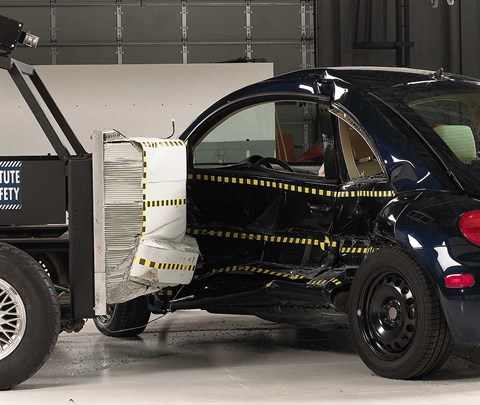Moderate overlap front: original test
Rating applies to 1998-2010 models built after June 1998
Tested vehicle: 1998 Volkswagen New Beetle 2-door
The Volkswagen New Beetle was reincarnated for the 1998 model year.
The Insurance Institute for Highway Safety has evaluated the crashworthiness of the New Beetle in a 40 mph frontal offset crash test into a deformable barrier. (Note: following discussion about restraint system performance in an initial offset test, Volkswagen changed the size of the driver airbag vent hole. Cars manufactured after June 1998 are equipped with the revised airbag design. Information about when a specific vehicle was manufactured is on the certification label typically affixed to the car on or near the driver door.)
The Institute conducted a second crash test using a New Beetle equipped with the revised airbag. This evaluation covers both tests. Ratings are based on the second test.
| Evaluation criteria | Rating |
|---|---|
| Overall evaluation | |
| Structure and safety cage | |
| Driver injury measures | |
| Head/neck | |
| Chest | |
| Leg/foot, left | |
| Leg/foot, right | |
| Driver restraints and dummy kinematics | |

Action shot taken during the frontal offset crash test.

The driver's upper interior survival space was maintained well.

Smeared greasepaint indicates where the dummy's head brushed the window sill during rebound.

Minimal intrusion into the driver footwell area helped earn the New Beetle's good rating for the performance of the structure/safety cage.
Side: original test
Rating applies to 2004-10 models
Tested vehicle: 2005 Volkswagen New Beetle GL 2-door with standard front seat-mounted combination head and torso airbags
The Volkswagen New Beetle was reincarnated for the 1998 model year. Front seat-mounted side torso airbags were standard initially and were upgraded to front seat-mounted combination head and torso airbags beginning with 2004 models.
| Evaluation criteria | Rating |
|---|---|
| Overall evaluation | |
| Structure and safety cage | |
| Driver injury measures | |
| Head/neck | |
| Torso | |
| Pelvis/leg | |
| Driver head protection | |
| Rear passenger injury measures | |
| Head/neck | |
| Torso | |
| Pelvis/leg | |
| Rear passenger head protection The dummy's head was hit by the pillar behind the rear side window. This pillar is required by federal standard to provide some protection for occupants' heads. | |

View of the vehicle and barrier just after the crash test.

View of the vehicle after the crash with the door removed, showing the side airbag and damage to the occupant compartment.

Action shot taken during the side impact crash test showing the driver dummy's head was protected from being hit by hard structures by the side airbag.

Smeared greasepaint shows where the rear passenger dummy's head was hit by the pillar behind the rear side window.
Head restraints & seats
Seat type: Seats with adjustable lumbar AHR
| Overall evaluation | |
|---|---|
| Dynamic rating | |
| Seat/head restraint geometry |
Seat type: Seats without adjustable lumbar AHR
| Overall evaluation | |
|---|---|
| Dynamic rating | |
| Seat/head restraint geometry |
About the head restraint & seat test
Currently, IIHS tests apply only to front seats.
